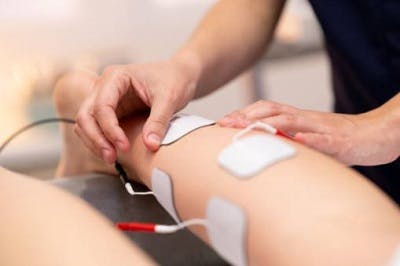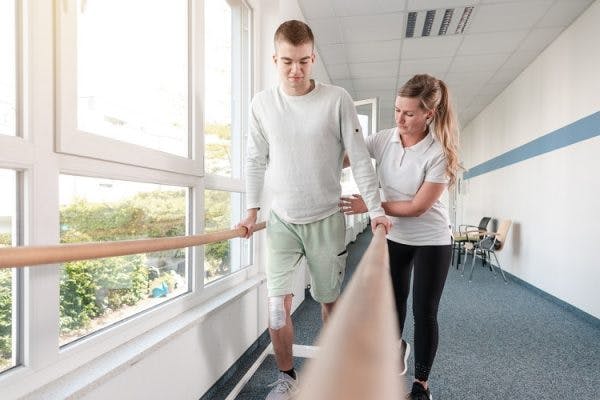Following a spinal cord injury, individuals may struggle with severe weakness or pain that impacts their ability to participate in rehabilitation. For an extra boost, therapists may recommend electrical stimulation to help stimulate movement, reduce pain, and stabilize autonomic functions below the level of spinal cord injury.
To help you understand what electrical stimulation is and how it can help with spinal cord injury, this article will discuss its:
How Electrical Stimulation Works for Spinal Cord Injury
To understand how electrical stimulation works for spinal cord injury, it’s important to understand how an SCI can affect your movements. The spinal cord is the communication pathway that relays signals between the brain and body.
In a complete spinal cord injury, signals may be unable to travel past damaged areas of the spinal cord. An incomplete spinal cord injury only partially disrupts the signals between the brain and muscles. In other words, some signals may still be able to travel past damaged areas.
In both complete and incomplete spinal cord injury, there can be loss of motor control and/or sensation in areas below the level of injury. Although the nerves below the level of injury remain undamaged, they cannot send or receive messages to or from the brain, so they become inactive.
Electrical stimulation can help individuals with SCIs recover motor control by stimulating undamaged nerves below the level of injury with electric currents. The electric currents mimic brain signals to re-activate the nerves, encourage the reorganization of pathways between the brain and body to promote communication and produce muscle contractions.
How to Maximize the Effects of Electrical Stimulation
Electrical stimulation has the potential to play a significant role in the future of spinal cord injury recovery. However, to optimize the effects of electrical stimulation, individuals must focus on promoting the central nervous system’s ability to reorganize its neural circuitry, neuroplasticity.
The only way to relearn how to move is to physically train the body to recognize movement patterns. The more an individual practices a movement, the better the spinal cord gets at recognizing a demand for that function.
For that reason, electrical stimulation is most effective when used in combination with intensive physical training. Individuals should use electrical stimulation to enhance neuronal activity below the level of injury, but focus on activating neuroplasticity in the spinal cord through highly repetitive, task-specific practice to promote long-term results.
Even if you can’t actively perform the stimulated motions, it’s important to keep the body moving passively (with help from a therapist or trained caregiver if needed) to support optimal recovery. Additionally, visualizing yourself completing the stimulated motions and focusing on trying to perform the movement during electrical stimulation sessions can boost neuroplasticity and promote recovery.
Now that you understand how to optimize the effects of electrical stimulation, the following section will discuss several techniques that utilize electrical stimulation to recover movement after spinal cord injury
Types of Electrical Stimulation for Spinal Cord Injury Recovery
You can use several types of electrical stimulation to promote recovery after a spinal cord injury. Some may help relieve secondary complications like pain while others focus on promoting movement.
Below, we’ll discuss 5 different electrical stimulation techniques that may be able to help facilitate better recovery outcomes after spinal cord injury.
1. Functional Electrical Stimulation (FES)

Functional electrical stimulation is a non-invasive treatment option that may be able to help individuals with spinal cord injuries produce functional movements.
This type of electrical stimulation involves placing electrodes on the surface of the skin over weakened muscles. Therapists control the strength and frequency of electrical emissions using a device. Rather than simulating the spinal cord, the electrical emissions stimulate the peripheral nerves to produce muscle contractions.
During functional electrical stimulation, the patient must perform a functional task (such as lifting an object from a table or bringing a cup to the mouth). By transitioning muscle contractions into functional movements, FES can help individuals optimize their independence after SCI.
There are various electrical stimulation devices that can be used for functional electrical stimulation, depending on the body parts affected. Some are simple, with just a small device and a few electrode pads. However, there are some that are more involved and can stimulate multiple muscle groups at once.
A couple examples include:
- Bioness devices. There are two main Bioness products, one of which stimulates the muscles affected in those with foot drop or thigh weakness, and another that stimulates the muscles required to grasp and release objects. These devices are able to be used during therapy sessions, however they are also available for home use to continue promoting increased functional use of affected extremities.
- Exoskeletons. These are wearable devices that can provide electrical stimulation to the lower body to stimulate the muscles involved in walking. Exoskeletons using FES are gaining popularity, but are still actively being researched.
2. Transcutaneous Electrical Nerve Stimulation (TENS)
Transcutaneous electrical nerve stimulation is a non-invasive form of electrical stimulation that involves placing electrodes on the surface of the skin to stimulate the sensory nerves.
This type of electrical stimulation focuses on relieving pain after spinal cord injury, not activating movement. While TENS won’t alleviate the source of pain, it may alter the way your brain perceives it. It accomplishes this by blocking pain signals and stimulating the production of endorphins.
Researchers are currently studying the following three applications of electrical stimulation as promising potential treatments for spinal cord injury.
3. Epidural Electrical Stimulation
Epidural stimulation is an invasive type of electrical stimulation that may significantly improve mobility after spinal cord injury. It involves implanting a stimulator and 16-electrode array directly onto the spinal column. Compared to non-invasive forms of electrical stimulation, epidural stimulation can activate the nerves at lower stimulation currents.
Clinical trials have demonstrated that even individuals with very severe or complete spinal cord injuries may be able to recover over-ground walking by utilizing epidural stimulation. Some experts also suggest that epidural stimulation may help stabilize blood pressure and improve bowel and bladder control.
4. Intraspinal Microstimulation (ISMS)
Intraspinal microstimulation is a type of electrical stimulation that involves implanting thin, flexible electrode wires into the lumbar region of the spinal cord. This allows for very precise muscle activation.
Surgeons place the hair-like wires in the gray matter of the spinal cord, where they send electric currents directly to the motoneuronal pools that control movement. Because it more precisely stimulates the spinal circuits, researchers hypothesize that intraspinal microstimulation can lead to more stable functional outcomes.
5. Brain-Computer Interface
The final epidural stimulation technique we will be addressing is brain-computer interface. This procedure has many different names including brain-machine interface, brain-controlled interface, neural-control interface, and mind-machine interface; however, they all refer to the same process.
Brain-computer interface involves placing electrodes near the primary motor cortex of the brain to monitor the intention to move. The electrodes emit electrical currents to restore functional activity in paralyzed limbs. Just by thinking about walking, individuals may be able to control the electrical stimulation that enables their legs to move.
Although this technique is still in its early stages of research and development, brain-computer interface appears to be a promising treatment for SCI patients with lower-body paralysis.
The video below shows an individual with lower-limb paralysis achieving over-ground walking during a brain-controlled interface trial.
To help you determine whether electrical stimulation is worth trying, the following sections will address some of its pros and cons.
Risk Associated with Electrical Stimulation for Spinal Cord Injury
Depending on the type of electrical stimulation you utilize, you may be susceptible to different types of risks. For example, non-invasive methods of electrical stimulation are not accompanied by the risks associated with surgery. However, these generally require higher stimulation currents, which can increase the risk of tissue damage, especially in those with impaired sensation.
Weaknesses and risks associated with electrical stimulation include:
- High costs
- Device complications (Lead migration and breakage appear to be the most common device-related issues.)
- Invasiveness (Patients should assume the general risks involved with any surgical procedure like infections or bleeding.)
- Discomfort (From the stimulator itself or the electric currents it emits)
- Lack of guarantees (Although promising, the mechanisms behind electrical stimulation have yet to be fully understood. Not everyone will experience the same results.)
Now that you’re familiar with the disadvantages of electrical stimulation, let’s discuss the benefits.
Benefits of Electrical Stimulation for Spinal Cord Injury
Electrical stimulation may be able to provide the extra boost necessary to help individuals recover movement after spinal cord injury.
Potential benefits of electrical stimulation for spinal cord injury include:
- Reduced pain
- Improved bowel and bladder control
- Stabilized blood pressure
- Enhanced movement patterns
- Reversibility (Implants can be removed and treatment can be stopped at any time)
- Availability of non-invasive options (FES and TENS)
- Improved self-esteem and confidence
Every spinal cord injury is unique and electrical stimulation may not be ideal for everyone. Often, electrical stimulation is not ideal for individuals with pressure sores, epilepsy, cardiovascular problems, or severe autonomic dysreflexia after spinal cord injury. If you’re interested in trying electrical stimulation, make sure to speak with your doctor or therapist to determine if it is ideal for your specific condition.
Electrical Stimulation for Spinal Cord Injury: Key Points
Electrical stimulation involves the use of electric currents to relieve pain or stimulate movement below the level of injury. Whiles these electric currents can successfully enhance movement patterns, it is essential to engage in an intensive rehabilitation program to retrain the brain, spinal cord, peripheral nerves, and muscles to work in sync again.
We hope this article helped you understand how electrical stimulation works and the best ways to promote optimal recovery outcomes.











